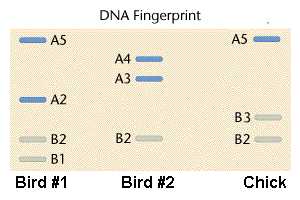
Microsatellite variation for parental inclusion / exclusion tests

Microsatellite variation for parental inclusion / exclusion tests
An avian ecologist wishes to know whether a particular chick in a communal nest is the offspring of Bird #1 who broods the nest, or of Bird #2 who feeds it. The principle of the test is that a parent and offspring must share at least one allele at every locus examined.
At locus B, the chick is [B2 / B3]: Bird #2 could be the parent [that is, she could have contributed the B2 allele]. However, Bird #1 could also have contributed the B2 allele. Therefore, analysis of locus B does not allow the exclusion of either bird as a possible parent. At locus A, the chick is [A5 / A5]: in this case, Bird #2 does not carry this allele and therefore cannot be a parent. Locus A allows the exclusion of Bird #2 as a parent. Bird #1 may be the parent [she could have contributed the A5 allele]. Calculation of the exact probability would require a knowledge of the frequency of each of the alleles in the population, based on analysis of many more individuals (or by inclusion of more microsatellite loci).